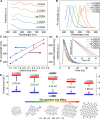Full-color fluorescent carbon quantum dots
- PMID: 33008913
- PMCID: PMC7852397
- DOI: 10.1126/sciadv.abb6772
Full-color fluorescent carbon quantum dots
Abstract
Quantum dots have innate advantages as the key component of optoelectronic devices. For white light-emitting diodes (WLEDs), the modulation of the spectrum and color of the device often involves various quantum dots of different emission wavelengths. Here, we fabricate a series of carbon quantum dots (CQDs) through a scalable acid reagent engineering strategy. The growing electron-withdrawing groups on the surface of CQDs that originated from acid reagents boost their photoluminescence wavelength red shift and raise their particle sizes, elucidating the quantum size effect. These CQDs emit bright and remarkably stable full-color fluorescence ranging from blue to red light and even white light. Full-color emissive polymer films and all types of high-color rendering index WLEDs are synthesized by mixing multiple kinds of CQDs in appropriate ratios. The universal electron-donating/withdrawing group engineering approach for synthesizing tunable emissive CQDs will facilitate the progress of carbon-based luminescent materials for manufacturing forward-looking films and devices.
Copyright © 2020 The Authors, some rights reserved; exclusive licensee American Association for the Advancement of Science. No claim to original U.S. Government Works. Distributed under a Creative Commons Attribution NonCommercial License 4.0 (CC BY-NC).
Figures





References
-
- Chun A. L., De Ranieri E., Moscatelli A., Vaughan O., Our choice from the recent literature. Nat. Nanotechnol. 10, 568 (2015).
-
- Li G., Tian Y., Zhao Y., Lin J., Recent progress in luminescence tuning of Ce3+ and Eu2+-activated phosphors for pc-WLEDs. Chem. Soc. Rev. 44, 8688–8713 (2015). - PubMed
-
- Weber M. D., Niklaus L., Pröschel M., Coto P. B., Sonnewald U., Costa R. D., Bioinspired hybrid white light-emitting diodes. Adv. Mater. 27, 5493–5498 (2015). - PubMed
-
- Lita A., Washington A. L. II, van de Burgt L., Strouse G. F., Stiegman A. E., Stable efficient solid-state white-light-emitting phosphor with a high scotopic/photopic ratio fabricated from fused CdSe-silica nanocomposites. Adv. Mater. 22, 3987–3991 (2010). - PubMed
-
- Jang E., Jun S., Jang H., Lim J., Kim B., Kim Y., White-light-emitting diodes with quantum dot color converters for display backlights. Adv. Mater. 22, 3076–3080 (2010). - PubMed
LinkOut - more resources
Full Text Sources

